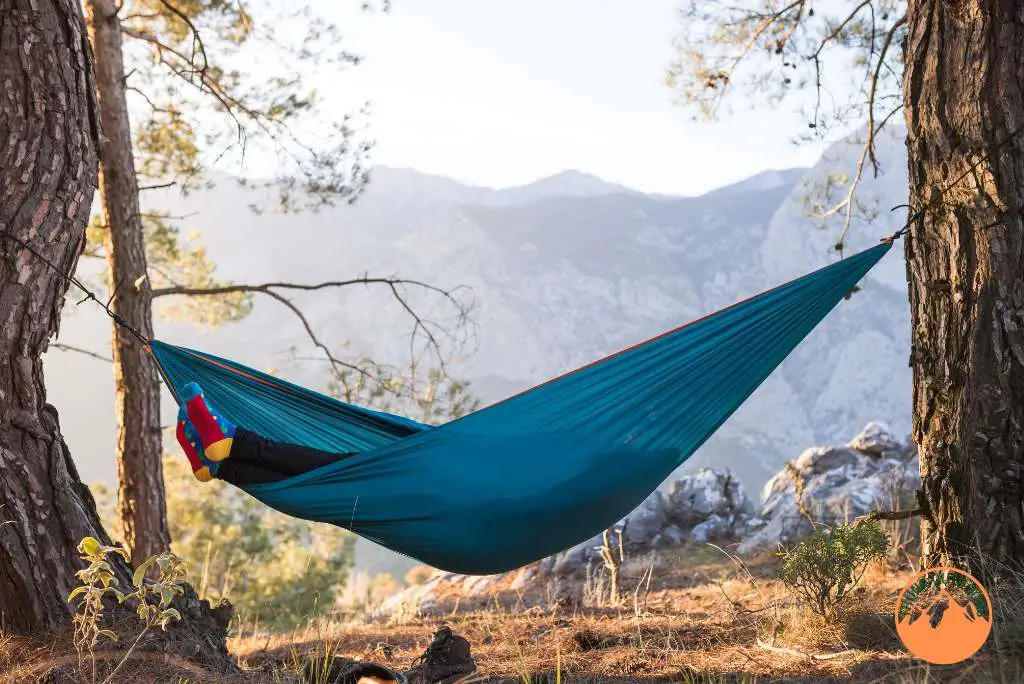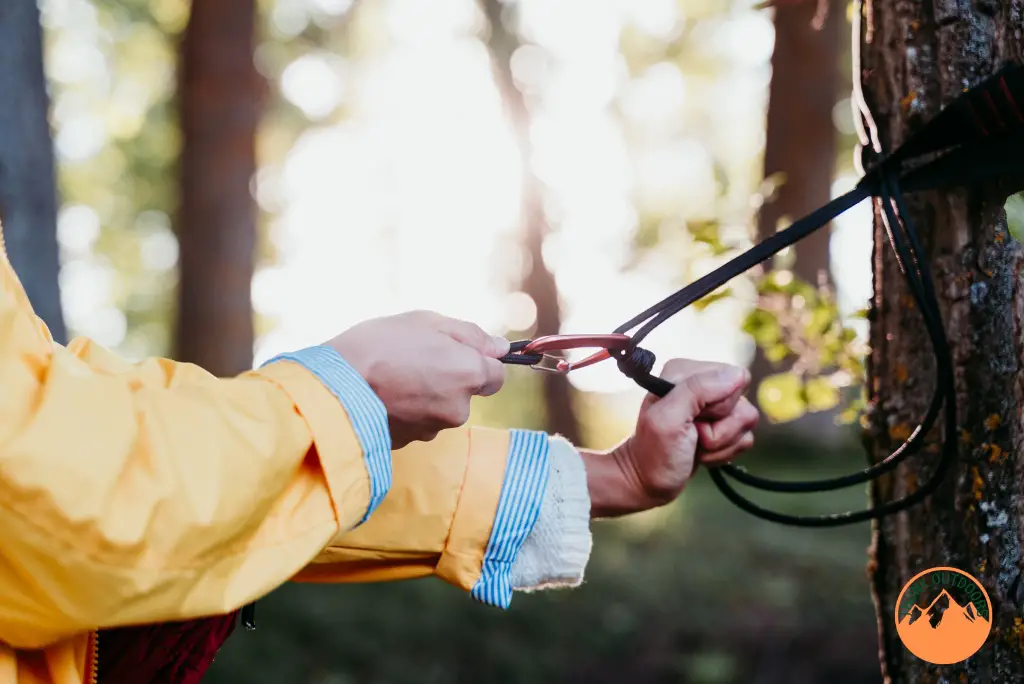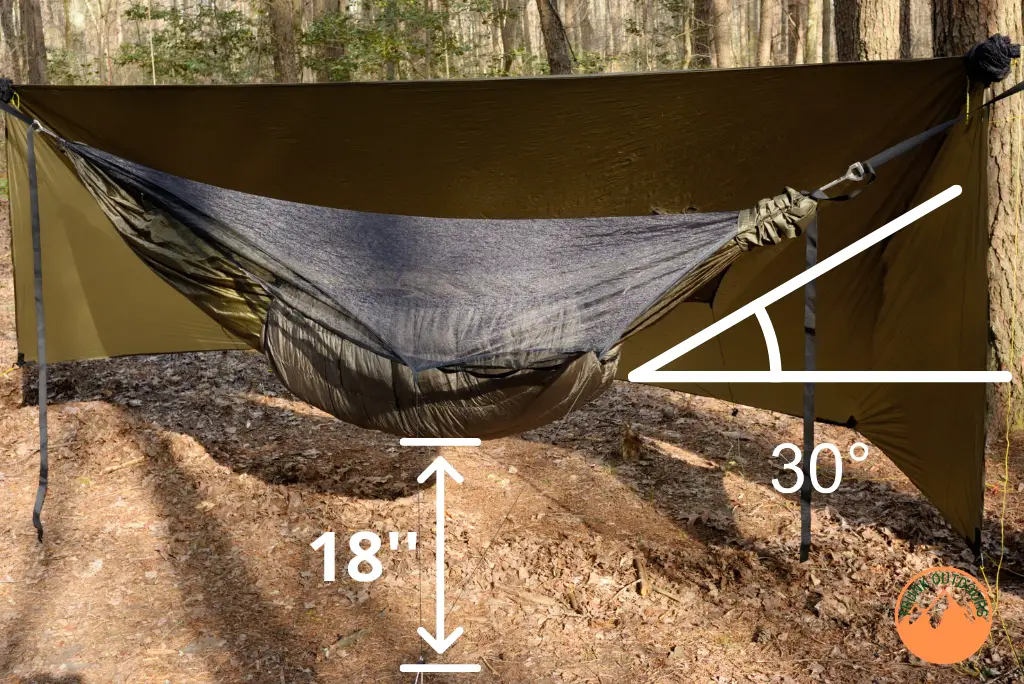How to Hang A Camping Hammock In 5 Easy Steps
Camping hammocks are increasingly popular among outdoor enthusiasts, offering a comfortable and relaxing way to enjoy nature.
However, hanging a camping hammock can be a bit challenging for beginners, and it’s important to get it right to avoid accidents, injuries, or damage to the environment.
In this guide, we will cover all the essential steps and tips on how to hang a camping hammock properly and safely, from selecting the right location and trees to adjusting the height and comfort of your setup.
How To Hang A Camping Hammock Between Two Trees?
To hang a camping hammock, you should follow these general steps:
- Find two sturdy trees or posts that are about 10-14 feet apart. Make sure they’re at least 4-5 inches in diameter and don’t have any dead branches that could break off.
- Wrap the tree straps or ropes around each tree, about 5 feet above the ground. Make sure the straps are flat against the tree and not twisted.
- Attach the carabiners on each end of the hammock to the straps. Make sure the hammock is level and not twisted.
- Adjust the height of the hammock to your liking. If it’s too high, it will be difficult to get in and out of. If it’s too low, you’ll be too close to the ground.
- Test the hammock by sitting in it and shifting your weight around. Make sure it feels stable and secure.
II. Choose the Right Location and Trees

When choosing a location to hang your camping hammock, it’s important to consider several factors to ensure a safe and comfortable experience.
- Look for a level area with enough space to hang your hammock between two trees, which should be sturdy, healthy, and at least six inches in diameter, to avoid damaging the bark.
- Trees should be about 10-14 feet apart from each other, have no obvious signs of insect infestation or dead branches, and be free of any overhead hazards, like branches or power lines that could pose a risk.
- You should pay attention to natural elements such as wind or sun exposure that could affect your comfort.
- It’s important to follow the Leave No Trace principles, including not setting up your hammock in fragile or sensitive ecological areas, and not causing any damage to trees or other natural features.
By taking these tips into account, you can ensure that you find the right location and trees that will provide a safe and enjoyable camping experience.
III. Gather Your Materials

To properly hang your camping hammock you will need the right tools and materials.
- To start, you’ll need a camping hammock (single or double-sized),
- Suspension system such as Tree Huggers or Slap Straps, carabiners, or S-hooks for attaching your hammock securely to the suspension system.
- You may want to bring extra accessories like a bug net, tarp, underquilt, or topquilt to enhance your camping experience.
There are different types of straps or attachment systems for hanging your hammock, such as webbing, rope, or cord, each with its pros and cons such as ease of setup, weight, and potential damages to the trees.
Choosing straps or suspension systems with multiple attachment points allows for more adjustability and stability.
Finally, you will want to keep your gear lightweight and compact for easy transport into your camping site. Use packing cubes to organize your gear and keep everything as streamlined as possible.
IV. Strap and Attachment Setup
Setting up your straps and attachment system for your camping hammock properly is essential for a safe and comfortable camping experience. It is important to follow the manufacturer’s instructions and recommendations specific to your gear to ensure proper setup.
- To begin, wrap the straps around the trees, about shoulder height or higher, leaving enough slack to feed the end of the strap through the loop.
- Ensure that both sides are wrapped at an equal height to keep the hammock level. Then feed the end through the loop and pull it tight.
- Attach the carabiners or S-hooks to the attachment points on your hammock, making sure they are securely fastened.
- Adjust the straps’ length until the hammock is balanced, so neither side is too low or too high off the ground, this prevents flipping or rolling out of the hammock during use.
Before getting into the hammock, double-check the security and stability of the setup, testing that the hammock can bear your weight without swaying or coming loose.
Tips: Tree saver straps are an essential tool for anyone who wants to hang objects from trees without causing damage.
These wide nylon or polyester webbing straps (at least 0.75 inches wide) are designed to prevent bark abrasion and protect the underlying layers of the tree that are vital to its survival.
Unlike ropes or cords, which can dig into the bark and cause harm, tree saver straps guard against these types of problems.
V. Adjust the Height and Comfort

Adjusting the height and comfort level of your camping hammock is crucial to ensure a peaceful and restful camping experience. Tips for adjusting the height of your hammock to a comfortable level include:
1# Adjusting the straps’ length to find a comfortable angle of inclination and suspension but no more than 18” off the ground and try to have a 30-degree strap angle.
You can adjust the height of the hammock by retying the knots, repositioning the attachment points, or lowering the strap’s height on the tree.
2# Fine-tuning the setup for maximum comfort and relaxation requires considering the season, weather conditions, and personal preferences.
- For warmth, consider adding a top quilt or underquilt, and for bug protection, add a bug net.
- For more comfort, try adding pillows, blankets, or inflatable sleeping pads.
3# With any adjustments, you should also keep safety precautions in mind.
- Always check the attachment points and straps for signs of wear and tear before use, and avoid overloading the hammock with too much weight.
- Use a hammock stand or thicker trees to avoid causing damage, and ensure that the hammock is correctly and securely fastened, so it doesn’t sway or collapse during use.
VI. Conclusion
In conclusion, it is essential to have the right tools and materials when hanging your camping hammock.
The strap and attachment system should be set up following the manufacturer’s instructions, ensuring proper height and balance before relaxing.
Adding accessories such as bug nets, underquilts, topquilts, pillows, and blankets can enhance comfort and relaxation in challenging weather conditions.
Safety precautions must be followed, including checking the setup’s stability and security before use, avoiding overloading the hammock with too much weight, and preventing potential damages to the trees.
Moreover, it is critical to leave no trace and respect nature by observing wildlife from afar, storing food securely, and disposing of trash properly.
Following these practices ensures safe and enjoyable camping experiences while minimizing any negative impacts on nature.